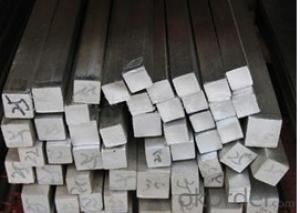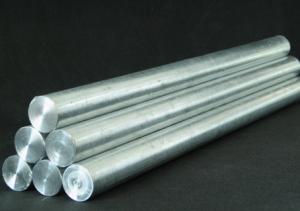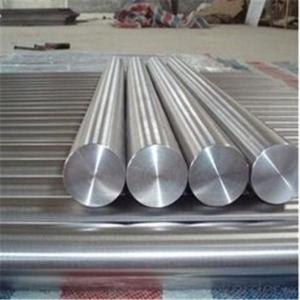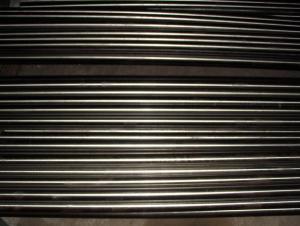12X18H10T Stainless Steel Bar
- Loading Port:
- China Main Port
- Payment Terms:
- TT or LC
- Min Order Qty:
- 5 Tons m.t.
- Supply Capability:
- 1000 Tons Per Month m.t./month
OKorder Service Pledge
OKorder Financial Service
You Might Also Like
Stainless Steel Bar
Stainless Steel Round Bright Bar
Hot-rolled Stainless Steel Black Bar
Grades:201、202、301、302、303、304、316、316L、321 etc
|
Diameter (mm) |
weight (kg/m) |
Diameter (mm) |
weight (kg/m) |
Diameter (mm) |
weight (kg/m) |
Diameter (mm) |
weight (kg/m) |
|
2 |
0.025 |
14 |
1.221 |
30 |
5.607 |
50 |
15.575 |
|
3 |
0.056 |
15 |
1.402 |
32 |
6.38 |
55 |
18.846 |
|
4 |
0.1 |
16 |
1.595 |
34 |
7.202 |
60 |
22.428 |
|
5 |
0.156 |
18 |
2.019 |
35 |
7.632 |
65 |
26.322 |
|
6 |
0.224 |
19 |
2.249 |
36 |
8.074 |
70 |
30.527 |
|
7 |
0.305 |
20 |
2.492 |
38 |
8.996 |
75 |
35.044 |
|
8 |
0.399 |
22 |
3.015 |
40 |
9.968 |
80 |
39.872 |
|
9 |
0.505 |
24 |
3.588 |
42 |
10.99 |
85 |
45.012 |
|
10 |
0.623 |
25 |
3.894 |
45 |
12.616 |
90 |
50.463 |
|
11 |
0.754 |
27 |
4.542 |
46 |
13.183 |
95 |
56.226 |
|
12 |
0.897 |
28 |
4.884 |
48 |
14.354 |
100 |
62.3 |

- Q: What are the applications of stainless steel bars in the chemical storage industry?
- Due to their numerous beneficial properties, stainless steel bars are widely utilized in the chemical storage industry. They are highly resistant to corrosion, making them perfect for storing and handling various chemicals. Stainless steel bars have the ability to withstand exposure to aggressive substances such as acids, alkalis, and solvents, which ensures the safety and integrity of chemical storage facilities. One of the primary applications of stainless steel bars in the chemical storage industry is their use in the construction of storage tanks and containers. These bars are used to fabricate the frames, walls, and roofs of the tanks, providing structural support and preventing leakage or contamination. Additionally, stainless steel bars contribute to the longevity of the storage tanks as they are not easily degraded or corroded under harsh chemical conditions. Moreover, stainless steel bars play a crucial role in the fabrication of pipes and tubing systems within chemical storage facilities. These pipes and tubes are essential for the transportation and distribution of chemicals within the plant. Stainless steel bars offer excellent resistance to high temperatures, pressure, and chemical reactions, ensuring the safe and efficient movement of substances. Furthermore, stainless steel bars find application in the construction of various equipment and machinery used in the chemical storage industry. They are utilized in the manufacture of pumps, valves, fittings, and other components that directly come into contact with chemicals. By providing durability, reliability, and resistance to chemical corrosion, stainless steel bars reduce the risk of equipment failure and improve overall operational efficiency. Additionally, stainless steel bars are often employed in the construction of chemical processing equipment, such as reactors and distillation columns. These bars offer a high level of thermal stability and mechanical strength, enabling the equipment to withstand extreme temperatures and pressures. Moreover, stainless steel bars resist the formation of deposits or contaminants on the equipment's surfaces, which enhances the purity and quality of chemical products. In conclusion, stainless steel bars have extensive and crucial applications in the chemical storage industry. Their corrosion resistance, durability, and versatility make them an ideal choice for constructing storage tanks, pipes, equipment, and processing systems. By utilizing stainless steel bars, the chemical storage industry can ensure the safety, integrity, and efficiency of its operations.
- Q: Are stainless steel bars suitable for telecommunications equipment?
- Yes, stainless steel bars are suitable for telecommunications equipment. Stainless steel is known for its durability, corrosion resistance, and strength, making it an ideal material for various applications including telecommunications equipment. Its resistance to rust and corrosion ensures the longevity and reliability of the equipment, while its strength allows it to withstand heavy loads and harsh environmental conditions often encountered in the telecommunications industry. Additionally, stainless steel's aesthetic appeal and versatility make it a popular choice for telecommunications equipment.
- Q: How do stainless steel bars compare to carbon steel bars?
- The composition, properties, and applications of stainless steel bars and carbon steel bars are distinctly different. Let's start with their composition. Stainless steel bars are primarily made of iron, with the addition of elements like chromium, nickel, and others. These added elements give stainless steel its unique corrosion-resistant properties, making it highly resistant to rust and stains. Conversely, carbon steel bars are mainly composed of iron and carbon, with small amounts of other elements. The absence of chromium and nickel in carbon steel makes it more susceptible to corrosion and rust compared to stainless steel. Moving on to properties, stainless steel bars offer superior strength and durability compared to carbon steel bars. They have a high tensile strength, enabling them to withstand heavy loads and resist deformation. Moreover, stainless steel bars have excellent heat and temperature resistance, making them ideal for high-temperature applications. On the other hand, carbon steel bars, while strong, generally have lower tensile strength and are more prone to deformation when subjected to heavy loads. Lastly, their applications differ significantly. Stainless steel bars are widely used in industries that require corrosion resistance, such as the production of kitchen utensils, medical equipment, and chemical processing plants. They are also commonly utilized in construction, automotive, and aerospace industries due to their strength and durability. In contrast, carbon steel bars find frequent use in applications that prioritize strength and cost-effectiveness over corrosion resistance. Examples include construction, manufacturing machinery, and infrastructure projects. To summarize, stainless steel bars and carbon steel bars exhibit differences in composition, properties, and applications. Stainless steel bars are renowned for their corrosion resistance, strength, and durability, making them suitable for various industries and applications. On the other hand, carbon steel bars, although less resistant to corrosion, offer strength and cost-effectiveness, making them ideal for applications that prioritize strength over corrosion resistance.
- Q: Are stainless steel bars suitable for aerospace engine components?
- Yes, stainless steel bars are suitable for aerospace engine components. Stainless steel has excellent corrosion resistance, high strength, and good heat resistance properties, making it a popular choice for various aerospace applications. In the aerospace industry, stainless steel bars are commonly used in engine components such as shafts, turbine blades, and compressor discs. These components require materials that can withstand high temperatures, extreme pressure, and corrosive environments, all of which stainless steel can provide. Additionally, stainless steel's ability to maintain its mechanical properties at both low and high temperatures makes it a reliable and durable material for aerospace engine components.
- Q: How do stainless steel bars resist sulfuric acid?
- Stainless steel bars possess exceptional resistance against various corrosive substances, such as sulfuric acid. This resistance can be attributed to the unique composition of stainless steel, which contains at least 10.5% chromium. The presence of chromium in stainless steel results in the formation of a protective layer called a passive film on its surface. When stainless steel bars come into contact with sulfuric acid, the passive film acts as a barrier, preventing direct attack on the underlying metal by the acid. This film is capable of self-healing, meaning that if it gets damaged or removed, it can quickly reform when exposed to oxygen. Consequently, stainless steel bars can maintain their corrosion resistance even in the presence of sulfuric acid. Moreover, the high chromium content in stainless steel provides additional protection against sulfuric acid. Chromium has an inherent ability to react with oxygen in the atmosphere, leading to the formation of a thin, invisible oxide layer on the surface of stainless steel. This oxide layer further strengthens the resistance of stainless steel bars against sulfuric acid, acting as an additional barrier between the acid and the metal. In conclusion, the combination of the passive film and the oxide layer formed by chromium enables stainless steel bars to endure the corrosive effects of sulfuric acid. As a result, they are a durable and dependable option for applications that require resistance against this acid.
- Q: Can stainless steel bars be powder coated?
- Yes, stainless steel bars can be powder coated. Powder coating is a process in which a dry powder is applied to the surface of an object and then heated to create a durable and protective coating. While stainless steel is known for its corrosion resistance, powder coating can provide additional benefits such as enhanced aesthetics, improved durability, and increased resistance to chipping, scratching, and fading. Powder coating stainless steel bars can also allow for customization in terms of color and finish, making it a popular choice in various industries, including architecture, automotive, and manufacturing.
- Q: What is the difference between solid and hollow stainless steel bars?
- The main difference between solid and hollow stainless steel bars lies in their structure. Solid stainless steel bars are completely filled and have a consistent diameter throughout their length. On the other hand, hollow stainless steel bars have a hollow center, resulting in a tubular shape. This difference in structure affects their weight, strength, and various applications.
- Q: What are the characteristics of austenitic stainless steel bars?
- Austenitic stainless steel bars possess exceptional resistance to corrosion, rendering them suitable for diverse applications across multiple industries. The presence of elevated levels of chromium and nickel is a prominent feature of these bars, contributing to their corrosion resistance. These elements facilitate the formation of a protective layer of oxide on the material's surface, effectively preventing rust and corrosion. Moreover, the high ductility and toughness exhibited by austenitic stainless steel bars facilitate easy fabrication and shaping into various forms and sizes. This characteristic allows for flexibility in design and construction. Additionally, these bars boast remarkable strength and are capable of withstanding high temperatures, making them ideal for deployment in extreme environments. Additionally, austenitic stainless steel bars possess commendable weldability, meaning they can be readily welded or joined to other materials without compromising their corrosion resistance or mechanical properties. This attribute makes them a favored choice for applications requiring robust and long-lasting connections. Furthermore, austenitic stainless steel bars possess a non-magnetic nature, which proves advantageous in certain industries, such as electronics and medical equipment manufacturing, where minimizing magnetic interference is crucial. This characteristic also enables easy differentiation from other types of stainless steel. In conclusion, the key attributes of austenitic stainless steel bars encompass excellent corrosion resistance, high ductility and toughness, favorable weldability, impressive strength, and a non-magnetic nature. These properties render them a widely utilized and versatile material in various industries, including construction, automotive, aerospace, and food processing.
- Q: Can stainless steel bars be used in pharmaceutical manufacturing?
- Yes, stainless steel bars can be used in pharmaceutical manufacturing. Stainless steel is often chosen for its excellent corrosion resistance, high strength, and durability. These properties make it suitable for use in various pharmaceutical equipment, such as mixing vessels, storage tanks, piping systems, and even manufacturing equipment for pharmaceutical tablets or capsules. Stainless steel is also easy to clean and sanitize, which is crucial in pharmaceutical manufacturing to maintain hygienic conditions and prevent cross-contamination. Additionally, stainless steel is non-reactive with most pharmaceutical substances, ensuring the integrity and purity of the final product. Overall, stainless steel bars are widely used in pharmaceutical manufacturing due to their favorable properties and compliance with industry standards.
- Q: What is the difference between stainless steel bars and carbon steel bars?
- The main difference between stainless steel bars and carbon steel bars lies in their composition. Stainless steel bars contain a higher percentage of chromium, which provides them with excellent corrosion resistance. They also typically contain nickel and other alloying elements, making them more durable and resistant to heat and chemicals. On the other hand, carbon steel bars have a higher carbon content, which gives them greater strength and hardness but makes them more susceptible to corrosion. Overall, stainless steel bars are ideal for applications requiring resistance to corrosion, while carbon steel bars are favored for their strength and toughness.
1. Manufacturer Overview
| Location | Jiangsu, China |
| Year Established | 2010 |
| Annual Output Value | above US$8 million |
| Main Markets | East Asia, Middle East, West Europe |
| Company Certifications |
2. Manufacturer Certificates
| a) Certification Name | |
| Range | |
| Reference | |
| Validity Period |
3. Manufacturer Capability
| a) Trade Capacity | |
| Nearest Port | Shanghai |
| Export Percentage | |
| No.of Employees in Trade Department | above 50 people |
| Language Spoken: | English, Chinese, Arabic |
| b) Factory Information | |
| Factory Size: | about 15000 square meter |
| No. of Production Lines | above 4 |
| Contract Manufacturing | OEM Service Offered,Design Service Offered |
| Product Price Range | Average |
Send your message to us
12X18H10T Stainless Steel Bar
- Loading Port:
- China Main Port
- Payment Terms:
- TT or LC
- Min Order Qty:
- 5 Tons m.t.
- Supply Capability:
- 1000 Tons Per Month m.t./month
OKorder Service Pledge
OKorder Financial Service
Similar products
Hot products
Hot Searches
Related keywords



























